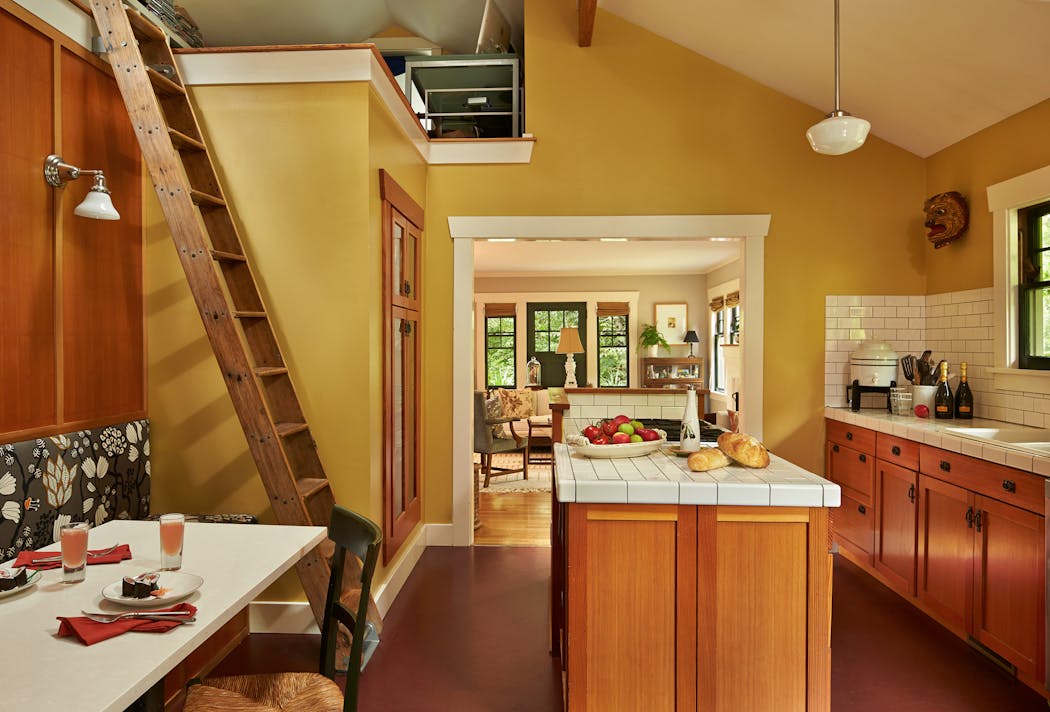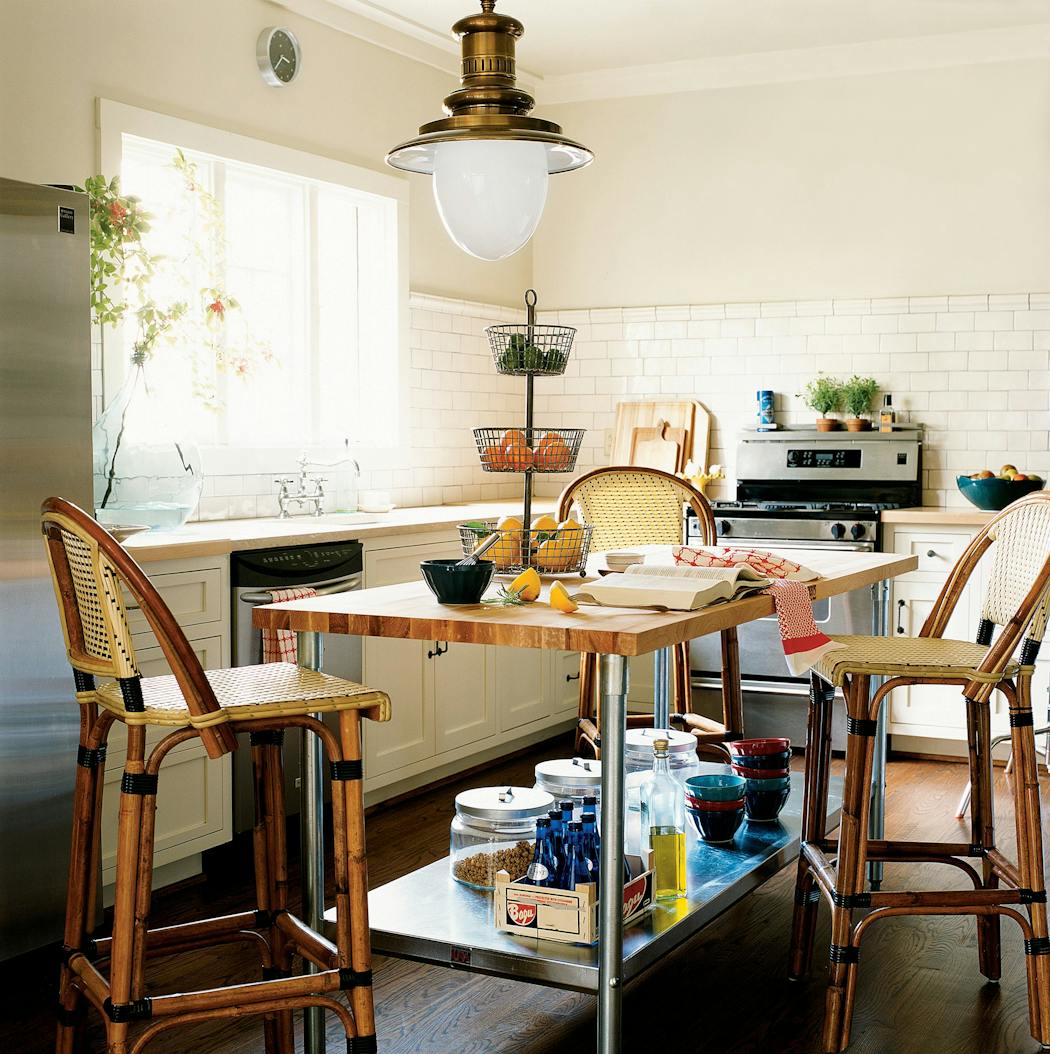For years, the "dream" kitchen has looked like nobody actually cooks in it — think pristine white cabinetry, vast expanses of stone countertops that seemingly never get dirty and antiseptic stainless steel appliances. In the name of renovating for resale, kitchens became austere and cold, stripped of personality and character. But change is brewing in the world of kitchen design, as cooking spaces get less, well, kitchen-y — and much more interesting.
Design writer Sophie Donelson, the author of the new book "Uncommon Kitchens," has deemed this trend the "unkitchen." When she started using the phrase in her talks and on social media, she says, "People really seized on the idea, they seemed to understand immediately what it meant — and they were invigorated by it. A lot of what the unkitchen idea promises is that there could be smaller updates, looseness — dare I say whimsy — involved in a room that has had a lot of the joy sucked out of it."
Donelson credits the desire for less kitchen-y cookeries to the British cottage kitchens by designers including Beata Heuman and Matilda Goad, which swept the design world a few years back. These kitchens were colorful, layered and playful; for example, Goad's cook space featured a backsplash of red and white glazed checkerboard tiles. And rather than hide her refrigerator, Heuman had hers tricked out to look like a Swedish armoire.
"Magazine readers, Instagram and Pinterest users, and design lovers saw these and it was almost as if they were experiencing the kitchen for the first time," says Donelson. "These British designers captured this sweetness and intimacy — a kind of collective memory about what a kitchen is like. These are rooms where life happens."
Hollie Velten-Lattrell, an interior designer in Maplewood, N.J., who is known for her colorful and unconventional kitchens, says that the pandemic may have also influenced the pivot away from renovated-for-Zillow white kitchens. "It really shook up our perception of self in relation to our home," she says. "Prior to COVID, we just were so busy and rarely home; we related to our space differently." Velten-Lattrell says her clients realized that life is short and unpredictable, and as a result, designed their home for themselves, rather than resale.
The layered look of an unkitchen also "cleverly allows for cooking messes, collections and passions, and everyday life to unfold without detracting from the space," says Donelson. You don't have to keep these kitchens perfectly tidy to enjoy them.
Aiming for a looser, more lived-in kitchen style is also more sustainable because it often means working with what you've got instead of ripping everything out. And even if you're saddled with white cabinets, stone counters and stainless steel appliances, you can make small changes to give the space an unkitchen look. Here are tips from Donelson, Velten-Lattrell and others on how to get started.
Bring in saturated color
Color — on walls, trim, cabinetry or even the ceiling — is a surefire way to banish the boring kitchen vibes. Boston-based interior designer Cecilia Casagrande has had several projects with perfectly nice but boring kitchens. Instead of ripping them out, though, Casagrande uses color to wake them up, in one instance painting the ceiling a bright yellow and adding red bar stools. Or Velten-Lattrell suggests painting the molding or doors (or both!) a bright color for a fun accent.
Add some softness
Bold, colorful textiles are another way to add personality. Try some playful curtains, Casagrande says, which can add pattern and create a homier look. Or replace some lower cabinet doors with a fabric skirt to soften a kitchen's hard edges.
Make yourself smile
"There's enough drudgery in the kitchen, there can be enjoyment, too," says Frances Merrill, the principal designer behind Reath Design in Los Angeles. "Put something in there that signals leisure, like art," she says.
Ingrid Fetell Lee, the author of the book "Joyful," who teaches a class on designing a joyful home, says, "I always tell my students to ask yourself, 'How do I want my home to feel?'" She recently took her own advice, painting the cabinets bright green and papering the walls with a cheerful garden-like pattern to capture the feeling of being on summer vacation.
Rethink your backsplash
Replacing tiles is the kind of mini-makeover that gives a fresh look without major renovation. Donelson says that an eye-catching tile, such as color-blocked cement, can divert attention from ho-hum white cabinets. Or install a patterned tile all the way to the ceiling to create a wallpaper-like effect. For an even more budget-friendly option, Velten-Lattrell suggests removing the old tile and skim-coating the wall, then painting.
Replace built-ins with furniture
You can shake up a room full of matching, fitted cabinetry with a vintage piece of furniture. Velten-Lattrell suggests using an antique table or workbench at the center of a kitchen in lieu of an "overbuilt" island, a choice that also can yield significant cost savings. Or replace a smaller wall of built-in cabinets with a vintage hutch. If a room feels heavy, she says, substitute "a nice cupboard or antique casegood, which can be quite a striking workhorse," for some — or all — of the upper cabinets.
Pepper in antique accessories
If it is impractical to bring in antique furniture, accent your space with smaller vintage pieces. Swap a ceramic crock from a big-box retailer for a vintage vase, or pick up some art at an estate sale. The more unexpected your accessories the better; Goad uses a swan-shaped ceramic vessel as a fruit bowl, for example.
Try a little lamp
Normally relegated to the living room, a table lamp, especially one with an interesting shade, instantly makes a space feel less kitchen-y. "I love a table lamp in the kitchen," says Merrill. "A lamp on a counter sends a signal that this is not just a workspace but a place to enjoy spending time in." And if an outlet is not available where you want a lamp, Donelson suggests a rechargeable cordless model.
Swap out soulless hardware
You can give your cabinets character with a strategic switch of knobs and pulls. "New hardware makes a huge difference, especially if you do something really hand-touched like a warm aged-brass latch or knob," says Velten-Lattrell. For a less expensive option, she suggests oversized wood knobs, which make kitchen cabinets look more like furniture; you can leave wood knobs unfinished to contrast with the cabinet, or paint them for a monochromatic look.
Cultivate comfort
Aesthetics aside, Merrill says that physical comfort is another key to creating a kitchen that feels like home. "We find that our clients appreciate this approach to ensuring that the kitchen is inviting, comfortable and a place to spend real time," says Merrill, who says she's a big fan of a comfortable chair in a kitchen.

This reporter didn't survive his audition for 'Survivor'
Spring's hot gift book features gorgeous found-nature photos

Jane Smiley hits again with 'Lucky' but what the what is that ending?

Biography details what 'Rulebreaker' Barbara Walters did to get to the top




